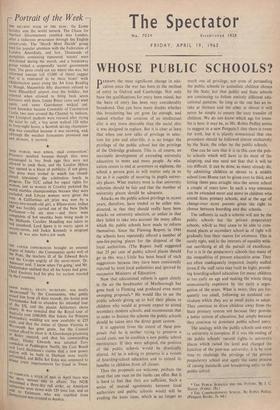WHOSE PUBLIC SCHOOLS?
rERFIAPS the most significant change in edu- cation since the war has been in the method of entry to Oxford and Cambridge. Not only have the qualifications for entry been raised, but the basis of entry has been very considerably broadened. One can have many doubts whether this broadening has yet gone far enough, and indeed whether the creation of an intellectual elite is any more desirable than the social elite it was designed to replace. But it is clear at least that when one now talks of privilege in selec- tion for jobs and after-life, it is no longer the privilege of the public school but the privilege of the Oxbridge graduate. This is, of course, an inevitable development of extending university education to more and more people. As edu- cation ceases to end at seventeen or eighteen, the school a person goes to will matter only in so far as it is capable of securing its pupils univer- sity places. What matters most is that university selection should be fair and that the number of university places should be adequate.
Attacks on the public school privilege in recent years, therefore, have tended to be either mis- directed, in that they should really have been attacks on university selection, or unfair in that they failed to take into account the many offers which the public schools have made to reform themselves. Since the Fleming Report in 1944 the schools have repeatedly offered a number of non-fee-paying places for the disposal of the local authorities. (The Report itself suggested that 25 per cent of public school places should go in this way.) Little has been heard of such suggestions because they have been consistently rejected by most local authorities and ignored by successive Ministers of Education.
Now that educational, reform is again clearly in the air the headmaster of Marlborough has gone back to Fleming and produced even more sweeping proposals.* He would like to see the public schools giving up to half their places to children who would at present expect to attend secondary modern schools, and recommends that in order to finance the scheme the public schools should be taken into the direct grant system.
It is apparent from the extent of these pro- posals that he is neither trying to preserve a social caste, nor to establish a new public school meritocracy. If they were adopted, the position of the public schools would be drastically altered. All he is asking to preserve is a system of boarding-school education and to extend its benefits to children from all classes.
Thus the proposals are welcome, perhaps the most that one man on the inside can offer. But it is hard to feel that they are sufficient. Such a series of mutual agreements between local authorities and public schools would still be evading the basic issue, which is no longer so
much one of privilege, nor even of persuading the public schools to assimilate children chosen by the State, but that public and State schools are continuing to follow entirely different edu- cational patterns. So long as the one has an in- take at thirteen and the other at eleven it will never be simple to ensure the easy transfer of children. We do not know which age for trans- fer is best; it may be, as Mr. Robin Pedley seems to suggest in a new Penguin,t that there is room for both, but it is plainly nonsensical that one procedure should be followed almost exclusively by the State, the other by the public schools.
One can be sure that it is in this case the pub- lic schools which will have to do most of the adapting, and one need not fear that it will be too difficult. It can be done, as 'many already do, by admitting children at eleven to a middle school (one House can be given over to this), and letting them pass straight into the senior school a couple of years later. In such a way entrance can be extended more and more to children who attend State primary schools, and at the age of change-over more parents given the right 10 choose between boarding and day schools.
The sufferers in such a scheme will not be the public schools but the private preparatory schools, which as they cease to be able to com- mand places at secondary school as of right will gradually lose their reason for existence. This is surely right, and in the interests of equality with- out sacrificing at all the pursuit of excellence. For it is in the preparatory schools that many of the inequalities of present education arise. They are often inadequately inspected, ineptly staffed (even if the staff ratio may itself be high), provid- ing boarding-school education for many children at too early an age and making the whole thing unnecessarily expensive by too early a segre- gation of the sexes. What is more, they are fre- quently too small, following an outdated cur- riculum which they are at small pains to adapt. They continue to draw children away from the State primary system not because they provide a better system of education, but simply because they continue to dominate public school entry.
The analogy with the public schools and entry to university is complete. If it was the ending of the public schools' natural rights to university places which raised the level and changed the function of the post-war university, it is by now time to challenge the privilege of the private preparatory school and apply the same process of raising standards and broadening entry to the public school.
* THE PUBLIC SCHOOLS AND THE FUTURE. 'By J. C. Dancy. (Faber, 18s.) t THE COMPREHENSIVE SCHOOL. By Robin Pedley. (Penguin Books, 3s. 6d.)


































 Previous page
Previous page